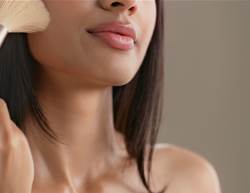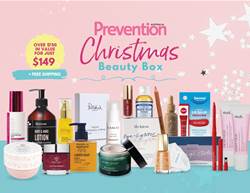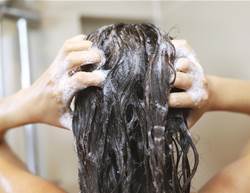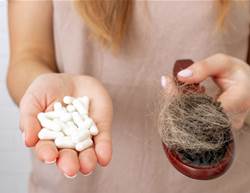Women use an average of 12 personal care products every day, exposing themselves to 168 chemicals, according to the Environmental Working Group. Men use half as many products but still come in contact with 85 chemicals daily.
(Want to pick up some healthier habits? Sign up for FREE to get healthy living tips, weight loss inspiration, slimming recipes and more delivered straight to your inbox!)
Experts say that many such ingredients are likely safe. But every researcher Prevention spoke with agreed that the lack of data is a major concern, particularly in cases involving long-term exposure.
And what many find troubling is that consumers aren't always aware of potential risks—ranging from allergic reactions and hair loss to asthma and cancer—and this hinders their ability to avoid potential hazards. "Too much of the burden is on the public, and it's unfair to expect the average person to have the time and scientific background to stay on top of this," says Russ Hauser, chair of the department of environmental health at the Harvard T.H. Chan School of Public Health.
Hauser is one of many experts pursuing answers. He's spent nearly 2 decades studying several chemicals of concern, including parabens and phthalates. Commonly found in lotions, shampoos and nail polishes, these ingredients belong to a class of chemicals called endocrine disruptors, which interfere with the functions of the hormonal system. Studies conducted by Hauser and others suggest that they may contribute to reproductive problems such as infertility (in both women and men), among other issues.
"The endocrine system regulates more than the reproductive system," Hauser says. "It also plays a role in immune function, metabolism and thyroid function." In 2016, a Toxicology in Vitro study revealed that exposure to phthalates may affect the amount of fat stored in the body, which could contribute to obesity. Four years earlier, Hauser and his colleagues published a study in Environmental Health Perspectives that linked increased concentrations of phthalates with a higher risk of diabetes.
"Hair straighteners and relaxers are formulated with oestrogen and placental hormones that could contribute to changes in the reproductive system," says Kyla Taylor, a health scientist at the National Institute of Environmental Health Sciences.
Age may also be a factor. Older women, Taylor says, have "probably used personal care products for many decades, so we're concerned about the possible effects of low-dose, long-term exposure."
Researchers are also looking at whether postmenopausal women, who have lower levels of oestrogen than premenopausal women do, may be more at risk. "Women who have been through natural menopause are more likely to develop cancer caused by hormonal factors," Taylor says. "And we know that the longer a woman is exposed to oestrogen, the higher her risk of breast cancer, for example."
Do products that contain oestrogenmimicking substances like parabens—found in lotions, body washes, shampoos and conditioners—raise a woman's risk of illnesses like cancer in the same way hormone therapy does? It's an open question. Here are some simple ways to protect yourself:
CHECK THE INGREDIENTS.
There's no guarantee that all will be listed, but it's still a good start. The EWG's Skin Deep database contains safety profiles and ratings of more than 70,000 personal care products so you can investigate and find safer options if necessary. Visit ewg.org/skindeep or download the free app. Another easy strategy: "Use simpler products with fewer ingredients," says dermatologist Steve Xu.
ARE DOWN YOUR STASH.
Go through your products to see if you can cut any. "For most people, a simple cleanser, moisturiser, and sunscreen are often enough," Xu says. Avoid using multiple products that offer the same benefits and contain the same ingredients. If you opt for a facial moisturiser containing alpha hydroxy acids, a scrub with AHAs may increase your chemical exposure with little added benefit.
BUY FROM REPUTABLE SOURCES.
Shopping for personal care products from unauthorised sellers on Amazon or eBay might save money, but there's no guarantee you're getting a safe product. A 2017 survey revealed that more than a quarter of respondents had unknowingly bought counterfeits—items that may contain dangerous ingredients such as lead—online. If you shop online, buy from a reputable site or from a brand's website.
BE WARY OF "NATURAL" PRODUCTS.
"Natural" and "botanical" aren't approved terms, so they're effectively meaningless. Xu says organic products aren't necessarily safer and can contain high numbers of allergens. If your skin is sensitive, undergo allergy testing before using these products.
GO FRAGRANCE-FREE.
To avoid parabens and phthalates, choose fragrance-free versions of products when scent isn't important.
FOLLOW DIRECTIONS.
Using too much of a product too frequently exposes you to higher amounts of chemicals. Use powders, aerosol sprays, nail polishes and hair dyes in well-ventilated areas to reduce exposure to airborne particles.
KEEP WEARING SUNSCREEN.
Many contain chemicals of concern, like the endocrine disruptor benzophenone. But the benefits of wearing sunscreen far outweigh any potential risks, Xu says.
LIMIT PREMOISTENED WIPES.
Many contain a preservative called methylisothiazolinone. The European Union's Scientific Committee on Consumer Safety states that no concentrations of methylisothiazolinone for leave-on products such as wipes should be considered safe, and the amount necessary to trigger contact allergies is unknown.
CONSIDER PRESCRIPTION RETINOIDS.
If you're concerned about harmful chemicals in anti-ageing products, ask your dermatologist to recommend a prescription retinoid. Since they're drugs, Rx retinoids such as Retin-A and Tazorac have undergone far more testing than over-the-counter wrinkle treatments.
SPEAK UP.
Report any adverse events from products to both the manufacturer and the Therapeutic Goods Administration.









